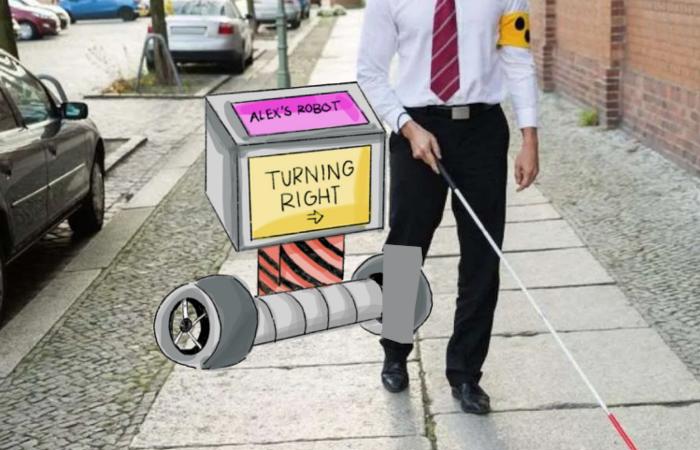A new study by Carnegie Mellon University researchers found that when roboticists and people with disabilities collaborate on robot designs, interesting ideas emerge that could make existing robots more accessible and inspire new uses.

Credit: Carnegie Mellon University
A new study by Carnegie Mellon University researchers found that when roboticists and people with disabilities collaborate on robot designs, interesting ideas emerge that could make existing robots more accessible and inspire new uses.
In their research, School of Computer Science faculty members Sarah Fox and Nikolas Martelaro highlight potential issues sidewalk robots encounter during deployment and propose solutions to mitigate them before the robots hit the streets. Their new study, led by Human-Computer Interaction Institute (HCII) Ph.D. student Howard Han, was presented last month at the ACM Conference on Human Factors in Computing Systems (CHI 2024).
Sidewalk delivery robots have experienced a recent boom in popularity, especially during the pandemic. But their proliferation comes with conflict, as they typically compete with pedestrians for limited sidewalk space. For people with mobility disabilities, a robot on the sidewalk can eliminate the only safe path, like when a delivery robot at the University of Pittsburgh blocked a wheelchair user from accessing a ramp in 2019.
The new research by Fox and Martelaro, both assistant professors in the HCII, draws on discussions they facilitated between roboticists and people with mobility disabilities to determine the most concerning accessibility problems and how robots can do better.
In the study, they found that one reason accessibility accommodations aren’t considered earlier in the design process is that most companies making sidewalk robots are startups, and things move quickly.
“There’s not really the time or incentive to slow down in the ways needed to get that type of input from a variety of stakeholders, including people with disabilities,” Fox said.
In interviews for the study, roboticists did acknowledge a lack of consideration for users with mobility challenges as a common problem in the field. However, they also expressed a desire for better industry standards and regulations that could help account for the needs of a variety of users, similar to the Web Content Accessibility Guidelines for web accessibility standards. These policies could drive technical design not only for delivery robots but also for other types of public robots.
“One of the things that we’re inspired by from this work is the notion of public service robots,” Fox said. “What’s fun about the most recent paper is that through this collaborative design opportunity of having people with disabilities and roboticists working together, they conceptualized a number of other ideas for robots that operate on the sidewalk and in public that aren’t just for delivery.”
For example, robots could clear sidewalks of debris or snow, provide directions, act as crossing guards, carry books and other supplies for people, or help humans shop in stores. Sidewalk robots could also report traffic or blocked paths. If the robot detects an issue that could impede access for users in wheelchairs, it could potentially alert them to it through a mobile app, much like Waze or Google Maps does for car traffic.
This work builds on a 2021 study that focused on how sidewalk robots inhibit access to public walkways, and a 2023 observational study Fox and Martelaro conducted in partnership with a company that ran a delivery robot pilot in Pittsburgh.
Across previous studies, Fox and Martelaro have documented the limitations of sidewalk robots.
“Most often, they’re operating around campuses,” Martelaro said. “Campuses are more controlled. They have walkways that are better managed and maintained. Also, the population is more likely to accommodate the robots.”
But when it comes to open world exploration — like the pilot that ran in the Pittsburgh neighborhoods of Garfield, Bloomfield and Lawrenceville — many challenges arise. Robots can’t traverse sidewalks that are broken or cluttered with parked cars, trash cans or other unexpected obstacles. Many of these robots would get stuck, fall into planters and require human assistance to get back on their way.
The new study uncovered additional limitations when these robots had to serve customers with disabilities. For example, while sidewalk robots can usually tote food from one location to another, users with mobility disabilities typically need the delivery person to come to their doorstep or even set a pizza on their countertop. Robots can’t complete that last stretch because they don’t yet know how to climb stairs or take an elevator.
“Accessibility is essentially a known problem,” Fox said. “Roboticists understand that consideration for accessibility often comes too late in the design process — often at the very end.”
But sometimes, accounting for these considerations could require dramatic redesigns or entirely new features.
“There were a number of interesting ideas where people saw potential use cases that could serve them. But the robot needs to be explicitly designed for that case,” Martelaro said. “If you step a little bit beyond a robot that rolls around and has some lights and visuals on it to something that has an arm on it, that becomes a more technically challenging task.”
Having different stakeholders involved in the design process also sparked interesting conversations about how the robots should look and the valuable tasks they could accomplish.
“There were some conversations specifically around the grocery-fetching robot,” Fox said. “One of the ideas was that it could stand up and reach something on a high shelf. The participant with a disability was pretty firm on this idea being something worth pursuing, and the roboticist said that this could actually scare people because it could be read as creepy or foreboding.”
Beyond brainstorming how to design robots, part of Fox and Martelaro’s future research also focuses on testing these designs in a cost-effective but expansive manner.
“This idea of engaging people has been a thread through our work. However, we’re trying to look into deeper engagement with relevant stakeholders,” Martelaro said.



